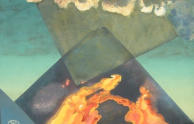



All texts copyright Richard Shillitoe
volcano
1972
Oil on paper laid down on board.
27 x 39¾in. (69 x 102cm.)
Monogrammed and dated lower left. Inscribed ‘Mt Etna Eruption,
1971’verso.
Provenance
Lay’s, Penzance, 2 June 1994, lot 410.
Lays, Penzance, 14 Oct. 2003, lot 576.
Lays, Penzance, 10 Feb. 2004, lot 22.
Private collection.
Exhibited
Exeter, City Art Gallery, 1972, no. 37.
Penzance, Newlyn Gallery, 1976, no. 86.
After nearly twenty years without any major eruptions, a series of eruptions started at Etna in April
1971 and continued intermittently for the next twenty-two years. Mt Etna is the highest volcano in
Europe.
At first sight, this is a straightforward, almost schematic, portrayal of volcanic eruption. The
pyramidal form of the volcano in the foreground contains brightly coloured flames of red, yellow and
orange. In the sky above, the expelled material rises in an inverted pyramid containing clouds of
steam and water vapour. The upper atmosphere is darkened by a dust haze.
Gibbons, 1996 (1) points to the importance of fire/water symbolism in Qabalistic and alchemical
thought, and its importance in a gendered universe. Quoting Paracelsus, Silberer and other
authorities, water is defined as ‘the mother of all things and over it broods the spirit of fire. When
fire acts on water, and strives with it, the first matter is evolved.’ (p83).
As is often the case with Colquhoun, hermetic symbolism is built into the forms of this work. A
triangle with point uppermost is the alchemical symbol for the element of fire, and a triangle with
the point downwards symbolises water. The partial super-imposition of the triangles suggests an
incomplete Seal of Solomon. This reading is reinforced by the presence of a horizontal marker that
crosses the painting at the place where the triangles intersect and which divide it into two roughly
mirroring halves, so yielding the idea of ‘as above, so below’.
In her essay “Fire and the Pyramid of Flame”, Colquhoun refers to the separate hermetic meanings
given to the three angles which make up the triangle of fire (see Nichols, 2007, pp. 93-94). (2) The
left basal angle is attributed to the Volcanic fire which flashes through the abysses of Earth. It is
surely significant, therefore, that she has chosen to demarcate this corner of the triangle by over-
painting it in a flat colour.
The thin transparent wash of dark pigment that covers the upper half of the painting may, prosaically,
represent a descending cloud of ash, but also the duality of dark and light.
Despite its superficial simplicity, the painting, is an image of alchemical transition in progress; of
change, instability, and metamorphosis.
notes
1. Gibbons, B.J. 1996. “Gender in Mystical and Occult Thought”. Cambridge: University Press.
2. Nichols, S. 2007. “The Magical Writings of Ithell Colquhoun”. Available from Lulu.com/multisell.


















